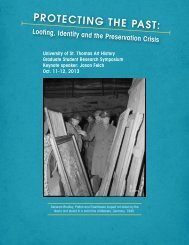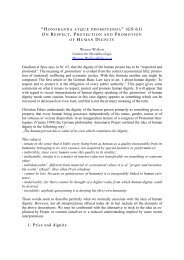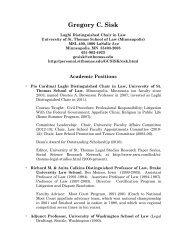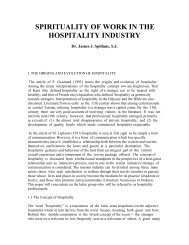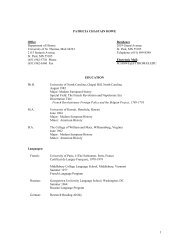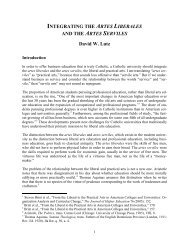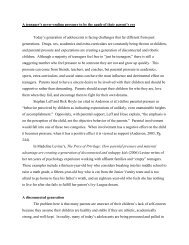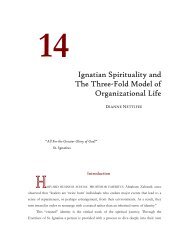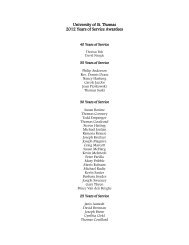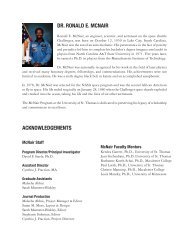McNair Research Journal - University of St. Thomas
McNair Research Journal - University of St. Thomas
McNair Research Journal - University of St. Thomas
Create successful ePaper yourself
Turn your PDF publications into a flip-book with our unique Google optimized e-Paper software.
Humanities & Social Sciences<br />
It is aimed to help support and promote equal education for all students,<br />
regardless <strong>of</strong> their living condition.<br />
However, the Act does not provide a federal guarantee <strong>of</strong> access to<br />
education for all homeless children, but rather requires states to guarantee<br />
that homeless children and youth have the same access to a ‘free appropriate<br />
public education’ as permanently housed children attending school in<br />
the same district. The mandate on residency is to ensure access for all<br />
homeless children and youth to some form <strong>of</strong> education, either in their<br />
district <strong>of</strong> origin for the remainder <strong>of</strong> the school year or where the child is<br />
temporarily living, which ever is in the best interest <strong>of</strong> the child. The<br />
difficulties homeless children and youth have faced based upon this<br />
requirement alone and the actions <strong>of</strong> the schools has caused many<br />
students to either leave school altogether, or be left grade levels behind<br />
their peers. According to Ramsey and Hennepin County directors,<br />
working in collaboration with supportive services is the best way to<br />
achieve this goal. The majority <strong>of</strong> supportive services in the two counties<br />
put priority on enrollment in school or GED attainment.<br />
Another barrier working against homeless students is that <strong>of</strong> the guardianship<br />
requirement. In many cases <strong>of</strong> homelessness, children <strong>of</strong>ten end up<br />
temporarily living with relatives who are not lawfully their guardians.<br />
More <strong>of</strong>ten than not, children in this situation are denied admission to<br />
schools because they have un<strong>of</strong>ficial guardians.<br />
Attaining records from schools in a timely fashion for transfer is a<br />
dilemma. Many schools require records from pervious schools for<br />
enrollment. More <strong>of</strong>ten than not, those records come with a fee that most<br />
homeless families and/or youth cannot afford. Furthermore, without<br />
records there have been reports <strong>of</strong> over-vaccinations. This information can<br />
be found in a student’s record, but without the availability <strong>of</strong> these<br />
records, many students are over-vaccinated and end up ill. This only adds<br />
to the list <strong>of</strong> worries with which homeless families and youth have to deal.<br />
Homelessness for families with children and unaccompanied youth are<br />
those rare cases that require the same, if not more, <strong>of</strong>fered services and<br />
programs than children and families who are not homeless. Homeless<br />
students are being excluded and denied comparable services as students<br />
with permanent home statuses. They are denied after-school programs,<br />
group work within classroom settings, and are excluded from field trips,<br />
leaving them feeling more disconnected from their peers. There is a need<br />
for schools and service providers to collaborate. There are ways to break<br />
through the barrier <strong>of</strong> non-comparable services: with community centers,<br />
service programs, and agencies working to accommodate, not isolate,<br />
homeless students from mainstream education. Offering forms <strong>of</strong><br />
education outside the school, but in collaboration with the schools seems<br />
to be the most logical and effective solution. In the past, there have been<br />
shelter-based after-school programs that concentrate on acceleration rather<br />
than remedial approaches to helping homeless children.<br />
The most pressing and <strong>of</strong>ten-cited barrier is that <strong>of</strong> the transportation.<br />
This problem derives both from the family (and their inability to learn<br />
about or afford transportation) and from school districts (unwillingness or<br />
inability to make special efforts to accommodate the needs <strong>of</strong> homeless<br />
children attending their schools). Transportation is the main reason so<br />
many homeless children and youth are not succeeding in the academic<br />
world; they simply have no way to get there. Directors <strong>of</strong> the two counties<br />
have issued transportation vouchers and have gone as far as to drive youth<br />
themselves. “This is a call far beyond duty, but rather <strong>of</strong> empowerment<br />
and engagement. Youth need to be inspired, to see role models, to have<br />
mentors. Can you think <strong>of</strong> a better example than us (staff )?”<br />
(Ramsey/Hennepin County director.)<br />
The Runaway and Homeless Youth Act, signed in June <strong>of</strong> 2006 is meant<br />
to serve the population <strong>of</strong> homeless youth who have been forced to leave<br />
their homes, or have chosen to leave due to their own specific circumstances.<br />
As defined by the Act, “homeless youth are persons twenty-one<br />
years <strong>of</strong> age or younger who are unaccompanied by by a parent or<br />
guardian and without shelter where appropriate care andsupervision are<br />
available. These are youth whose parent or guardian is unable or unwilling<br />
Maria Ortiz<br />
Homeless Youth Services<br />
to provide shelter and care, or who lack a fixed, regular, and adequate<br />
nighttime residence.” The act is designed to hold the “commissioner” responsible<br />
for developing a report for homeless youth, which must include<br />
coordination <strong>of</strong> services as defined within the Act (subdivision 3-5).<br />
The subdivisions are services that consist <strong>of</strong> street and community outreach,<br />
and drop-in programs; (3) emergency shelters programs; (4) and<br />
supportive housing and transitional living programs (5). After conversations<br />
with Beth Holger, a member <strong>of</strong> the Minnesota Department <strong>of</strong><br />
Human Services, Homeless Youth Programs, the conclusion was made<br />
that the leading cause for homeless youth is the systemic issue <strong>of</strong> poverty,<br />
which causes conflicts within families. Poverty is associated with the lack<br />
<strong>of</strong> affordable housing, livable wages, healthcare services, and educational<br />
services (DHS & NCH 2009).<br />
According to the Department <strong>of</strong> Human Development and Family<br />
Science at Ohio <strong>St</strong>ate <strong>University</strong>, proper drop-in centers make possible the<br />
setting for homeless youth to go into treatment and back into mainstream<br />
society. When serving such a population, there is a need to provide the<br />
essentials at a “one stop shop” drop-in center - a location in which all<br />
necessities may be found as well as services provided. In Washington,<br />
D.C., a “one stop shop,” N-<strong>St</strong>reet Village, has had a pr<strong>of</strong>ound affect on<br />
those who use the facility. Transportation is no longer an issue when<br />
everything is in one location, and many have benefited from this this<br />
type <strong>of</strong> facility.<br />
Minnesota <strong>St</strong>atute 123A.06 says that the programs and services <strong>of</strong> a<br />
center must focus on academics and learning skills, specific to applied<br />
learning opportunities, trade and vocational skills, work-based learning<br />
opportunities, work experience, youth service to the community transition<br />
service, and English language and literacy programs. Main objectives<br />
for these centers are to serve the people for whom these services were intended,<br />
obvious enough. But knowing the needs <strong>of</strong> each individual who<br />
passes through the doors can be difficult; this is why there are intakes as<br />
well as case managers assigned to those who choose to use such services.<br />
Homeless Management Information Systems (HMIS-HUD) have worked<br />
to create a web-based database for supportive service providers. It is<br />
important to track those that are using the services for funding, and<br />
licensing requirements. “Intakes and assessments are important to hold all<br />
parties accountable” (Ramsey/Hennepin County director).<br />
Methods<br />
<strong>Research</strong> with a vulnerable population such as youth, and more<br />
specifically homeless youth, requires the approval <strong>of</strong> the Institutional<br />
Review Board. It is the duty <strong>of</strong> the board to ensure that all methods <strong>of</strong> an<br />
individual’s research is ethical. My process began in August, 2008, and I<br />
was approved in January <strong>of</strong> 2009.<br />
In March, 2009, I conducted face-to-face interviews with Directors <strong>of</strong><br />
Homeless Youth Service Providers in Ramsey and Hennepin Counties.<br />
Directors where called and <strong>of</strong>fered an opportunity to participate in the<br />
study “Bridging the Gaps: Homeless Youth Services.” Before interviews<br />
could take place, directors were required to read and sign a letter <strong>of</strong><br />
consent, acknowledging and showing an understanding <strong>of</strong> their role and<br />
mine the study.<br />
Homeless Youth were involved in a focus-group survey at the various<br />
service providers’ locations. Youth were recruited through cooperative efforts<br />
with the service providers. Flyers were posted with all information<br />
and an incentive for a chance to win a $10 gift certificate to Cub Foods.<br />
This study defines homeless youth with the same criteria used by the<br />
United <strong>St</strong>ates Congress in allocating resources through the McKinney-<br />
Vento Act (P.L. 100-77, sec 103 (2) (1), 101 stat. 485 [1987]):<br />
Youth who currently have no parental, substitute, foster or institutional home<br />
to which they can safely go. They are unaccompanied by an adult and have<br />
spent at least one night either in a formal emergency shelter, improvised<br />
shelter, doubled-up, or on the streets.<br />
44 <strong>University</strong> <strong>of</strong> <strong>St</strong>. <strong>Thomas</strong> <strong>McNair</strong> <strong>Research</strong> <strong>Journal</strong>



